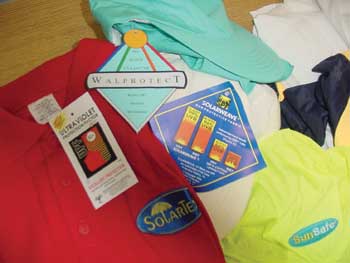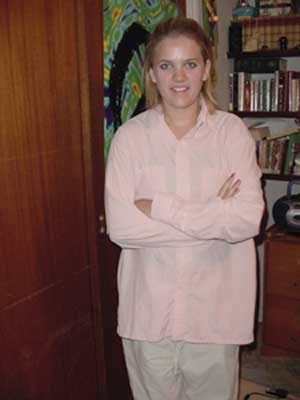Beyond Sunscreen Lotion
Ultraviolet protection by fabrics
2003
Arizona Agricultural Experiment Station Research Report
![]()
Written by
Joanne Littlefield

UV labeling that is easy for the purchaser to understand is the goal of research
by the American Society for Testing and Materials.
Arizonans spend a lot of time in the sun.With more than 300 days of sunshine per year in the desert, everyone’s skin needs to be protected from potentially harmful ultraviolet (UV) radiation outdoors. Research has determined that sun exposure and sunburning of skin is linked to skin cancer and premature aging of the skin. Sunscreen lotions are probably the number one means of protection from UV rays, but another effective means is to wear clothing that covers arms and legs as well as the trunk of the body.
“Simply wearing cover-up garments from our closets can reduce the sun’s radiation dose to our covered skin by at least one-fifth,” says Kathryn Hatch, professor in Agriculture and Biosystems Engineering at the University of Arizona. “And often the reduction is more than that. Purchasing UV-protective garments that are labeled with sunburn protection information attached is an even better way of protecting skin while in the sun.”
As a textile scientist, Hatch collaborates with other textile scientists and researchers in disciplines such as dermatology and light physics who are interested in the use of clothing as an effective means for sunburn protection. They also work with entrepreneurs interested in developing UV-protective garments. Her focus is in two main areas: developing methods for testing fabrics to their UV protection capability, and using these methods to study how cotton and other fabrics can be altered to enhance sunburn protection capability.
Hatch chairs the International Committee on UV Protective Fabrics and Clothing of the American Society for Testing and Materials (ASTM) and serves on the UV Protection and Clothing Technical Committee within the International Commission on Illumination (CIE).
As chair of the ASTM committee she guided the development of two standard documents. One of them makes sure that the UPF values marked on sun protective clothing tell the purchaser the least amount of sunburn protection that will be provided during the product’s useful life. Committee members agreed that fabrics had to be laundered repeatedly and subjected to sun and chlorine water exposure before they could be tested to determine sunburn protection capability. They also agreed that only when the exposed fabric had a UPF (ultraviolet protection factor) value of at least 15 could it be labeled and sold as sunburn-protective.
“Whenever a health claim is being made, the level of protection (the UPF value) communicated must be correct,” Hatch says, “and the conditions under which it applies must be communicated.”
Hatch’s research with collaborators at Iowa State University and University of Nebraska, as well as research of others, has found that old cotton shirts, washed 10 times or more, may offer good sunburn protection (UPF 15).
“It’s because detergents contain optical brightening agents that deposit on cotton, rayon and linen fabrics during fabric washing,” Hatch says. These agents enhance the sunburn protection of these materials because they absorb some UV radiation. The research team also laundered cotton shirts with a laundry additive product developed especially to enhance sunburn protection capability of fabrics. The UPF of the fabrics reached 15 with one wash. Unfortunately, this product is not yet available to the public.
“Fabric manufacturers are eager to engineer fabrics to provide UPF values of 50 or more” says Hatch. There is common agreement that the cloth has to be tightly constructed. “Fabric has holes in it — sometimes barely perceptible, pinprick-sized holes. If it didn’t have any holes, then we would collapse from heat exhaustion because we wouldn’t have any evaporative water loss from our skin surface to cool us.”
Hatch notes that when UV rays go through those miniscule holes there isn’t anything there to stop them, they just go right on through. The idea is to have the fewest and smallest holes possible in sunburn protective cloth.
There has been tremendous interest in engineering cotton and rayon textiles for sunburn protection because these are the fabrics people like to wear out in the sun in hot weather. Consumers say rayon and cotton fabrics breathe. Textile scientists say they have good water vapor permeability even when tightly constructed. That is because water vapor molecules can pass through the rayon and cotton fibers as well as through the fabric holes, according to Hatch.
“However, cotton and rayon fibers are just not good UV filters,” she says. “They do not absorb enough of the harmful UVB and UVA rays to be as protective as they should be.”
Fortunately, research has established that manufacturers can produce cotton fabrics providing UPF values of 15 or greater through wise choices of dyes and UV-cutting agents, and/or blending of cotton fiber with fibers such as polyester that are good UV absorbers.
Work is currently underway to find dyes with the best UV-absorbing spectrums and to establish the concentrations of those dyes on fabric that yield good to excellent sunburn protection. Firms specializing in textile chemical finishing and those producing UV-absorbing compounds for sunscreen lotions have developed UV-cutting agents that hold fast to cotton and rayon fabrics, Hatch says. Garments made from these fabrics are available for purchase and come with a UPF value indicated on the product label.
|
Further, companies have developed UV-cutting agents to add to detergents and fabric softeners but these products are not yet available commercially. Some researchers are now looking at developing test procedures that will lead to labeling fabrics and clothing for people with special needs, including people who have skin disorders such as xeroderma pigmentosum, solar urticaria, and chronic actinic dermatitis that are aggravated by sun exposure; and people who have developed a photosensitivity from applying topical medications to the skin or taking certain medications. New testing procedures are needed because the solar radiation that is primarily responsible for aggravating these conditions is not the same as those causing the skin to sunburn. In some cases it is rays in the visible portion rather than ultraviolet portion of the solar spectrum, that are causing the problem, according to Hatch. |
 |
|
Specialty clothing manufacturers
have designed shirts, pants, hats and even swimwear that offer varying
degrees of sun protection. Katie Littlefield models a nylon blend
shirt and pants.
|
In all cases, each fabric must be tested to determine its ability to protect from solar radiation, as this cannot be known from visual observation nor calculated from descriptions of a fabric’s composition and structure.
“Look for labels on fabrics and clothing that specify the type and degree of protection provided,” Hatch advises. “Please remember that only the skin that is covered with fabric is being protected from solar radiation.”
CONTACT:
Kathryn Hatch
(520) 621-7134
khatch@ag.arizona.edu
Return to the Title Page
Return to the Table of Contacts
The University of Arizona is an Equal Opportunity/Affirmative
Action Employer. Any products, services, or organizations that are mentioned,
shown, or indirectly implied in this publication do not imply endorsement
by the University of Arizona.
Published January 2004
Return to College publication list